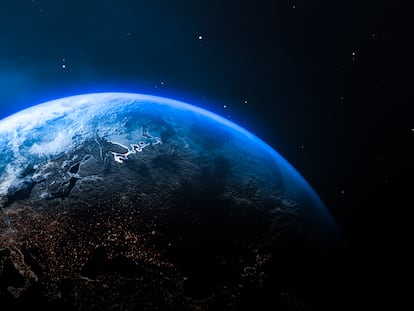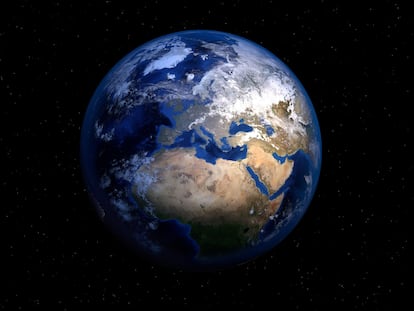A study suggests that the Earth’s interior hides the remnants of another planet
The mysterious dense layers of the Earth’s mantle could be remains from our planet’s collision with the protoplanet Tea 4.5 billion years ago
The scientific community faces a tremendous mystery. Deep in the Earth’s mantle, some 1800 miles (2,900 kilometers) below the ground, two gigantic masses lie beneath West Africa and the Pacific Ocean. They are layers of rock that behave surprisingly. When there is an earthquake, seismic waves slow down as they pass through these mysterious materials, suggesting that their composition is denser than the rest of the Earth’s mantle. On Wednesday, an international team of researchers published a fascinating hypothesis: these masses, which occupy thousands of miles, are the remnants of another planet that embedded in the Earth following a collision 4.5 billion years ago.
Chinese geologist Qian Yuan admitted it was “a crazy idea” when he presented it a couple of years ago at a virtual conference. Now, his team has developed the idea and published it in Nature, a leading international science journal, and it’s no longer such a crazy idea. “With the new evidence, I would say it is very likely,” Yuan told EL PAÍS. The authors remind us that fifty years ago the theory that the Moon was formed from products of the Earth’s collision with another young celestial body the size of Mars gained traction. In that scenario, the embryonic planet, called Tea or Theia, collided with the early Earth. Computer simulations by Qian Yuan and colleagues suggest that part of Tea’s molten mantle penetrated the original Earth’s mantle and solidified, subsequently sinking and forming the extensive anomalous seismic zones that now intrigue scientists. In Greek mythology, the deity Tea was the mother of Selene, the personification of the Moon.
The authors note that 8% of the Earth’s mantle is composed of iron oxides, as compared to the Moon’s estimated 10%. The research team estimates that Tea’s mantle was also richer in iron, which would explain why it sank deep in the boundary with the Earth’s core. Geophysicist Edward Garnero of Arizona State University was one of the scientists who responded to the “crazy idea” with great interest two years ago. “I think it’s completely viable until someone proves to me that it’s not,” he told Science at the time. Now, Garnero is himself a co-author with Qian Yuan of the California Institute of Technology on this new study.
The researchers estimate that a significant amount of Tea’s mantle —equivalent to 2% of the Earth’s mass— was embedded in the Earth’s mantle. Professor Hongping Deng of the Shanghai Astronomical Observatory in China, a co-author of the study, said in a statement that “our findings challenge the traditional idea that the major impact caused the homogenization of the early Earth… The major impact that formed the Moon appears to be the origin of the early mantle’s heterogeneity and marks the starting point of Earth’s geological evolution over 4.5 billion years.”
The authors argue that these enigmatic anomalous seismic zones in the Earth’s mantle are simply a “natural consequence” of the collision that gave rise to the Moon, but they also mention other hypotheses that they consider more unlikely, such as the solidification of magma or the accumulation of sunken oceanic crust in subduction zones.
A couple of years ago, Durham University (UK) seismologist Jenny Jenkins explained in the journal Science that Tea’s remains could just be a grave in a graveyard of planets. Scientists have found more pockets of dense materials deep in the mantle; they are perhaps remnants of other small planets that collided with the early Earth, says Jenkins. Geologist Qian Yuan says that “it’s possible, but it’s also likely that this stuff came from a mixture of the Earth’s mantle and Tea’s core.”
Yuan’s team emphasizes that such heterogeneity in the Earth’s mantle can surface in events like the ones that formed the volcanic islands of Iceland and Hawaii. Chemical clues to the major impact that created the Moon 4.5 billion years ago can be found in the black basalt rocks in these places.
Sign up for our weekly newsletter to get more English-language news coverage from EL PAÍS USA Edition
Tu suscripción se está usando en otro dispositivo
¿Quieres añadir otro usuario a tu suscripción?
Si continúas leyendo en este dispositivo, no se podrá leer en el otro.
FlechaTu suscripción se está usando en otro dispositivo y solo puedes acceder a EL PAÍS desde un dispositivo a la vez.
Si quieres compartir tu cuenta, cambia tu suscripción a la modalidad Premium, así podrás añadir otro usuario. Cada uno accederá con su propia cuenta de email, lo que os permitirá personalizar vuestra experiencia en EL PAÍS.
¿Tienes una suscripción de empresa? Accede aquí para contratar más cuentas.
En el caso de no saber quién está usando tu cuenta, te recomendamos cambiar tu contraseña aquí.
Si decides continuar compartiendo tu cuenta, este mensaje se mostrará en tu dispositivo y en el de la otra persona que está usando tu cuenta de forma indefinida, afectando a tu experiencia de lectura. Puedes consultar aquí los términos y condiciones de la suscripción digital.
More information
Últimas noticias
Most viewed
- David King, chemist: ‘There are scientists studying how to cool the planet; nobody should stop these experiments from happening’
- Reinhard Genzel, Nobel laureate in physics: ‘One-minute videos will never give you the truth’
- Mexico completes its trade shift with the entry into force of tariffs on China and countries without trade agreements
- Oona Chaplin: ‘I told James Cameron that I was living in a treehouse and starting a permaculture project with a friend’
- Sinaloa Cartel war is taking its toll on Los Chapitos












































